3DO Interactive Multiplayer 101: A Beginner’s Guide
Presented by Ack
Note from racketboy: The RetroGaming 101 series is aimed at gamers who are just starting out in the classic gaming scene or are curious about an older console that they don’t know much about yet.
When console gamers and collectors think back to 1993, most likely think of the glory days of the battle between Nintendo and Sega. Memories of handling gray controllers with purple buttons or shouting the Sega scream come to mind. But 1993 was an important year for the next generation of gaming, the era of the Sega Saturn, Sony PlayStation, and Nintendo 64. Because in 1993, the 32-bit era officially began with the release of the 3DO. Unfortunately it wasn’t much of a start, and the 3DO was quickly overshadowed by the industry juggernauts. Yet, while mainstream gaming has left it behind, the 3DO has found a home amongst retro gaming collections.
Background Information
- The official title of this console is the 3DO Interactive Multiplayer, but 3DO is the accepted abbreviation that the console is most commonly called. 3DO is also the title the 3DO Company is most often referred by.
- The original release date for the 3DO was October 4, 1993 in North America. It priced at $699.95 USD. The original version was produced by Matsushita(known as Panasonic outside of Japan). Later versions were produced by Sanyo and Goldstar, though even more companies had rights to produce their own variants.
- The 3DO developed by the 3DO Company is actually a set of specifications for the console, which was then licensed to various electronics manufacturers, hence its development by several corporations. The 3DO Company would then retain a small royalty percentage whenever a console or game was sold.
- The 3DO featured a limited game collection, with fewer than 250 titles appearing on the console.
- The 3DO was officially discontinued in 1996, after selling only about 2 million units. The 3DO Company eventually went defunct in 2003.
- The 3DO was partially the brain-child of Trip Hawkins, one of the founders of Electronic Arts.
Historical Impact
- The 3DO was the first 32-bit console to reach the market.
- The family of consoles was one of the few real attempts to have a “universal†platform/format for games (like we have with audio and video formats). However, the competition at the time was too strong for it to catch on.
- Was named “Product of the Year†by Time Magazine in 1994. It also received the “Worst Console Launch†award from Electronic Gaming Monthly in 1993.
- Was only one of many consoles on the market in the mid-1990s, which helped to contribute to its failure and general obscurity to the mass market.
- The 3DO featured the first CD music visualizer of any game console on the market. It was marketed heavily as an Audio Visual device instead of simply another game console, a strategy that such companies as Sony and Microsoft would later adopt.
- The 3DO Company developed its own optional ratings system for use by publishers. This ratings system predated the ESRB.
Strengths
- Though the console featured only a single controller port, controllers also had ports built in so they could be daisy-chained together, with up to eight controllers being supported. All controllers were compatible with all controller ports.
- Was the first 32-bit gaming console on the market, and was entirely CD-ROM-based. Models range from top-loaders to front-loaders, and could hold varying amounts of CDs, up to five at once.
- Featured an extremely liberal licensing policy, so developers could make far more money on successful game sales than on any competitor’s machine.
- Was compatible with audio and photo CDs, and could handle video CDs via the use of certain expansion modules.
- Supported stereo sound, as well as RF, Composite, and S-Video.
- Featured no region locking, meaning almost any game from any region could be played on any 3DO, regardless of that machine’s region.
- Capable of playing CD-Rs.
- Used its own OS for standardization across its products.
- Featured an internal saving system for games.
- Featured a wide array of first and third-party peripheral controllers.
Weaknesses
- The launch price was prohibitively expensive, and despite later variants featuring lower prices, the machine kept a reputation for costing too much.
- Limited third-party support. Despite the licensing policy, relatively few developers created games for the console, and these vary vastly in quality.
- Because it was released earlier, the 3DO’s CD technology is not up to par with later consoles like the Sega Saturn or Sony PS1.
- Despite being called an “audio visual device,†the 3DO lacks quality non-gaming material.
- Certain 3DO units have issues with ribbon cables becoming loose, which can lead to the CD tray not opening properly.
- A bug in the 3DO OS caused clicking noises while audio tracks were playing in several early games. Despite the problem being resolved, some playback problems still occurred, so game audio can sometimes be accompanied by popping sounds.
- Internal saves can only be erased by using a disk that features a memory management system. Many 3DO games and demo discs included this feature, though not all.
- Early 3DO controllers have difficulty performing a roll command on the D-pad, making it difficult to play certain games that require the command.
- Not all games are compatible across regions, since non-Japanese games lack the required kanji characters. While many games featured these programmed onto the disc, not all do.
- Because consoles were put out by different companies, certain specialty controllers and a handful of games are not compatible with certain consoles, particularly the Goldstar 3DO models.
Hardware Specifications
- 640×480 pixel resolution, with either 16-bit color drawn from 24 bits, or true 24-bit color.
- Two accelerated video co-processors with 25 MHz clock rate, able to produce 9-16 million pixels per second.
- CPU: 32-bit 12.5 MHz RISC CPU, the ARM60, manufactured by ARM Holdings.
- 2 MB DRAM, 1 MB VRAM, 1 MB ROM. 32 KB battery backed SRAM.
- 16-bit Stereo Sound, with 44.1 kHz Sound Sampling Rate. Fully supports Dolby Surround Sound.
- CD-ROM drive with 320ms access time, 300 KBps data transfer, and 32 KB RAM buffer
- 32-bit OS specially designed for the 3DO Interactive Multiplayer.
- Two expansion ports built into the console.
Accessories
- Standard peripherals for the 3DO include a light gun, controllers, and even wireless controllers from Logitech and Nakitek.
- Other controllers included a steering wheel, the 3DO mouse from Panasonic, a six-button controller made by Capcom, and various joysticks.
- An MPEG add-on that added an extra 256 KB of storage space received an extremely limited release for the console, mainly in Japan.
- Though Sega Genesis controllers do not work with the console and may damage it, the Genesis extension cables are compatible with the 3DO and its controllers. (you have to cut them down a little) FM Towns extension cables work as well.
- A Super Nintendo controller adapter was released for the 3DO.
- A digital video cartridge was released by various manufacturers for use with their 3DO models, allowing the 3DO to play Video CDs. Only the Goldstar version was released in the United States.
- Other accessories that never made it beyond the prototype stage include a modem designed by AT&T.
Hardware Variations
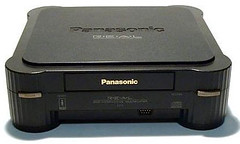 |
Panasonic FZ-1 Price Range: $115 – $375 The Panasonic FZ-1 was the first 3DO released to the public. It featured a front-loading CD tray, and controllers included headphone jacks and volume controls. Find the Panasonic FZ-1 on eBay |
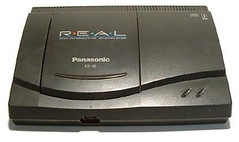 |
Panasonic FZ-10 Price Range: $140 – $260 The Panasonic FZ-10 is an updated top-loading version of the FZ-1. The controllers were made smaller and lighter, though the headphone jack was removed. Find the Panasonic FZ-10 on eBay |
 |
Panasonic ROBO 3DO Price Range: ??? The Panasonic ROBO 3DO was a Japan-only variant of the FZ-1, with a five disc CD drive. It was apparently meant for installation in hotels. Find the Panasonic ROBO 3DO on eBay |
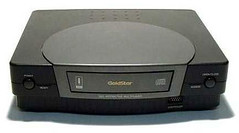 |
Goldstar 3DO Interactive Multiplayer Price Ranger: $90 – $150 The Goldstar 3DO looks similar to the Panasonic FZ-1 and featured a similar front-loading try. It even included a certificate to send in with a roll of film for custom-made photo CDs from Goldstar. The Goldstar 3DO Alive II is apparently a South Korean variant of this. Find the Goldstar 3DO on eBay |
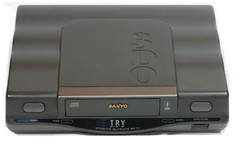 |
Sanyo TRY 3DO Interactive Multiplayer Price Range: $350 – $500 The Sanyo TRY 3DO was a Japan-only release by Sanyo. This is the rarest 3DO model. Find the Sanyo TRY 3DO on eBay |
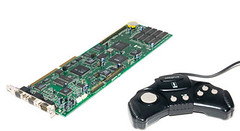 |
Creative Labs 3DO Blaster Price Range: ??? The 3DO Blaster, from Creative Labs, was a PC compatible ISA compatibility card for use with the Windows 3.1 OS, which allowed users to play 3DO games on their PCs. Instead of simply emulating them, it included everything down to the controller ports Find the Creative Labs 3DO Blaster on eBay |
- Other consoles from AT&T and Samsung were canceled. A portable version for use as a car navigation device by Toshiba was also canceled. And though Scientific-Atlanta were a 3DO licensee, they produced though hardware though there were some plans to.
- The 3DO’s successor, the M2, was supposedly completed(or was close to completion) by Panasonic when it was canceled in 1997 due to the 3DO’s poor sales. Some promotional material was released, and a few prototypes have made their way into collectors hands. The M2 technology would find its way into other machines, ranging from an arcade board by Konami to coffee vending machines.
Hardware Shopping Considerations
- The top loading models due have a tendency towards higher reliability than the front loaders, though the Japan-only Sanyo model is the rarest, and it apparently featured faster CD-ROM speeds.
- The Goldstar 3DO was another front loader and the cheapest in terms of price, and it was made available through toy stores and the like. Goldstars tend to have problems with a handful of games, and I saw at least one mention of issues with ribbon cables coming loose, though again front loaders were typically less reliable anyway. (According to GameSpy, Cyberia, PO’ed, and The Horde have a tendency to lock up when being played on a Goldstar.)
Importing
- As mentioned above, there was not region-locking on the games. However there are a few issues involving importing 3DO games.
- There seems to be just a few titles and a demo that don’t run properly when imported from Japan: Blue Forest Story, Twinkle Knights, Sword and Sorcery, and the Alone in the Dark demo. However, Alone in the Dark was released as a full game in the west, and there is an English version of Sword and Sorcery, called Lucienne’s Quest, so those two can be gotten around. And Twinkle Knights is apparently a adult video game, so…yeah.
- Also, certain non-PAL titles have trouble on PAL consoles, such as Twisted, Crash N Burn, and Way of the Warrior. PAL games will appear in a letterbox format on NTSC consoles apparently.
Emulation
- FreeDO is pretty much it for a 3DO emulator. Though updates stopped for a while in 2007, it was recently updated to version 2.1 in January, 2010. FreeDO is compatible with Windows.
- While versions are not currently publicly available, versions of FreeDO are supposedly being developed for the GP32X, Dreamcast, Lynux, and even the Wii Virtual Console. However, as it’s been several years since some of these announcements, it is unknown if any of these will appear for public use.
Affiliate programs and affiliations include, but are not limited to, the eBay Partner Network or Amazon Associates.
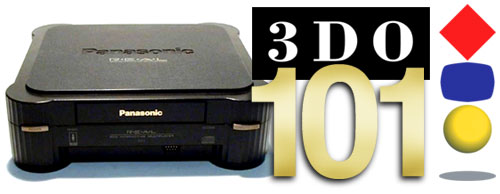
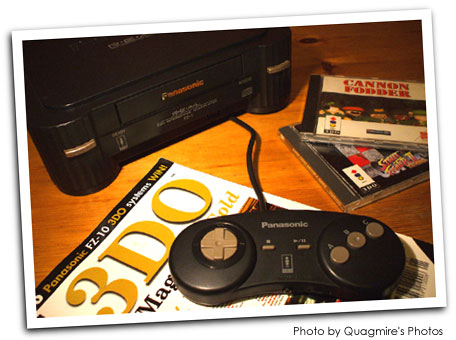
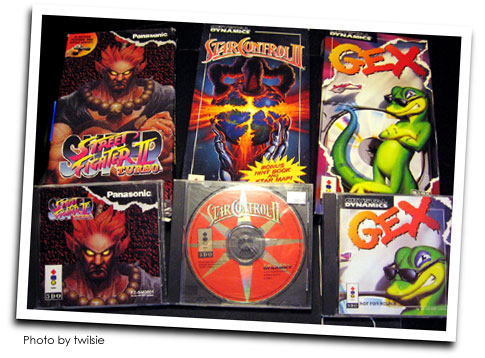
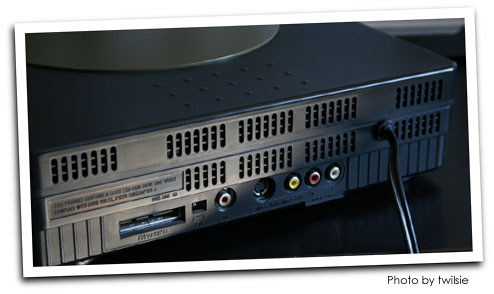
I didn’t recommend playing any FMV games, besides Dragon’s Lair. Just because there are FMV games on the system that doesn’t mean there isn’t anything else.
I don’t think your opinion of Samurai Showdown is a common one. It always seemed good to me.
You would also need to own multiple other systems and a pc to play all of the games available on the 3DO and there are a couple of exclusives that are worth playing like Lucienne’s Quest. I suppose my point was if you spend time actually playing the games instead of comparing them with every other port available you can get some enjoyment out of the 3DO.
When I owned one as a teenager it was the only cd based system I had and it wasn’t common for people to have every system on the planet available to them so they could pick and choose the best port of every game that came out. I got plenty of enjoyment out of the system.
Also, since you admit to not having played the lion’s share of what I listed I find your argument to be flawed because the games I listed are a good deal of the best titles on the system.
“You would also need to own multiple other systems and a pc to play all of the games available on the 3DO and there are a couple of exclusives that are worth playing like Lucienne’s Quest. I suppose my point was if you spend time actually playing the games instead of comparing them with every other port available you can get some enjoyment out of the 3DO.”
That’s the dilemma of the internet right there: The people who enjoy comparing the strengths and weaknesses of similar products would be really helpful to normal people if we weren’t crazy nerds whose opinions nobody valued.
I acknowledged that my experience with the system is limited, but that doesn’t make me any less qualified to second-guess some of your suggestions that I did not enjoy playing. Excuse me for being the first person to recommend some games for the system after several requests, and for being the only person to offer any sort of description or opinion on any of them.
I don’t think someone who paid for a 3DO when it was new is standing on any ground to criticize people who own multiple game systems.
This isn’t the forum for this discussion so this is the last I will say on the matter.
People who owned a system during the time it was relevant are obviously more qualified to speak about the strengths and weaknesses that it had when it came out.
I don’t particularly care if you like the system or not. I was expressing my opinion just like you were.
You made broad stroking generalizations about the worth of the system on a whole based on the limited scope of games you tried on it, hence the flaw in your argument.
You may as well say that a deck of cards is useless because you don’t like the design of the joker card.
And in response to this:
“The people who enjoy comparing the strengths and weaknesses of similar products would be really helpful to normal people if we weren’t crazy nerds whose opinions nobody valued.”
Because someone has a differing opinion than your own doesn’t mean your opinions aren’t valued by anyone. I also made no such claim of you being a “crazy nerd” or anything else for that matter. You should lighten up.
As a matter of a fact, if we’re going to compare ports (which 3DO does admittedly have a lot of), many 3DO ports were superior to their brethren. 3DO received a number of PC ports which were upgraded for the system (Star Control II, Space Hulk,, as well as a number of multi-system games that faired better on the more powerful 3DO (such as Night Trap, Flashback, Out of This World), as well as original 3DO games that didn’t port as well to other systems (Need For Speed, Gex, Road Rash, etc.). And yes, at the time, 3DO was the best non-arcade (or home Neo Geo) method to play Samurai Shodown and Street Fighter II.
Sort of makes me want a 3DO again. When I originally bought one(after price drops),as I look at it now, it was to stand out from the crowd. And that it had better(or just different) graphics than what we were use to, even more so the games were just unique. Total Eclipse was the game of choice and nothing could touch it, even that racing game “that title skips me at the moment”(the cars were equipped with weapons) was cool. Well standing out from the crowd had it’s price, leading to it easy to sell off for the next generation system (or the system everyone else was playing), not enough A+ or Arcade titles.
“”””At 5/11/2010 3:35 PM, Ivo said…
I thought the Amiga CD32 was released before the 3D0 and was the first 32-bit system released. The wiki page says September 1993, so I am right if that date is correct and the 3D0 was indeed in October.””””
The truth is neither the 3DO or Amiga CD32 was the first CD based game system. The Fujitsu FM Towns Marty was the first it was released February 16, 1993
hey cool article, i found it because i got a 3do in hard rubbish and can’t make it work! i think it’s american so i got a converter (i live in australia) and even though there is a voltage difference, it powers up. however then all it does is flash “access” and the cd tray won’t open. onscreen the logo pops up for a second, then just blank. any ideas?? i really want to play dragon’s lair!
Well Cal, mine has the same problem. I believe it is due to a failed CD drive. I bought my Panasonic FZ-10 at an AT&T store back during it’s original Launch. Yes, I paid the $700 for it. When I did buy it, AT&T was also launching an AT&T branded console. I will do some digging to back this up. I have all my original packaging and docs for it. Also a handfull of games that were mailed to me from the 3DO company (all stamped demo but, full working copies”. I may scan and post birthday cards that were sent to me from 3DO too. Anyone interested in some of the things I got from them were quite interesting. One card I got had a messege “Thanks for Believing in the dream”.
ACTUALLY the FM T owns Marty was the first 32-bit console. It was released in Japan only, 7 months before the Amiga CD32. 3DO is not the first 32-bit console, and neither is the Amiga CD32.
DONE THROUGH 3DS INTERNET BROWSER.
ACTUALLY the FM T owns Marty was the first 32-bit console. It was released in Japan only, 7 months before the Amiga CD32. 3DO is not the first 32-bit console, and neither is the Amiga CD32.
DONE THROUGH 3DS INTERNET BROWSER.
YOU are an idiot, FM owns was exclusive to ONE country and CD32 was also exclusive to certain regions 3DO was available EVERYWHERE so you fail. I hate nerds like you who have a snobish attitude cuz you can goole wikiedia articles. So unless you fucking lived in Japan at that time there was no such thing as FM towns was there? same with CD32 if you lived in the US it did not exist either. So get a fucking life moron.
Does anyone know if the American light gun is compatable on a British console?
Yes it 🙂
I was the one that bought the dino park tycoon from ebay the loose disc 🙂
One correction here. The Goldstar Alive II model, which was only released in South Korea, is actually very different than the first Goldstar model, having a top loader setup, and is rarer than the Japan-only Sanyo model.